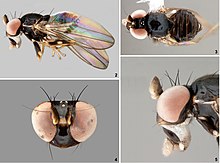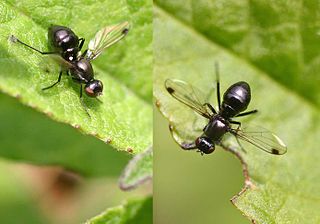
The Sepsidae are a family of flies, commonly called the black scavenger flies or ensign flies. Over 300 species are described worldwide. They are usually found around dung or decaying plant and animal material. Many species resemble ants, having a "waist" and glossy black body. Many Sepsidae have a curious wing-waving habit made more apparent by dark patches at the wing end.

The Conopidae, also known as the thick-headed flies, are a family of flies within the Brachycera suborder of Diptera, and the sole member of the superfamily Conopoidea. Flies of the family Conopidae are distributed worldwide in all the biogeographic realms except for the poles and many of the Pacific islands. About 800 species in 47 genera are described worldwide, about 70 of which are found in North America. The majority of conopids are black and yellow, or black and white, and often strikingly resemble wasps, bees, or flies of the family Syrphidae, themselves notable bee mimics. A conopid is most frequently found at flowers, feeding on nectar with its proboscis, which is often long.
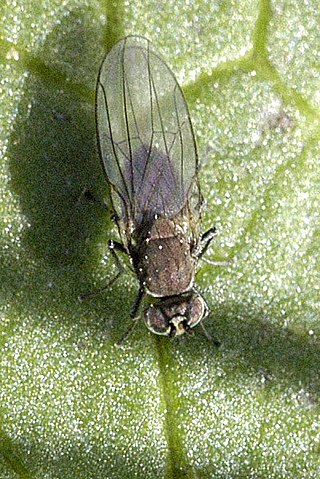
Ephydridae is a family of insects in the order Diptera.

The Fanniidae are a small group of true flies largely confined to the Holarctic and temperate Neotropical realms; there are 11 Afrotropical species, 29 Oriental, and 14 Australasian.

The Micropezidae are a moderate-sized family of acalyptrate muscoid flies in the insect order Diptera, comprising about 500 species in about 50 genera and five subfamilies worldwide,. They are most diverse in tropical and subtropical habitats, especially in the Neotropical Region.

The soldier flies are a family of flies. The family contains over 2,700 species in over 380 extant genera worldwide. Larvae are found in a wide array of locations, mostly in wetlands, damp places in soil, sod, under bark, in animal excrement, and in decaying organic matter. Adults are found near larval habitats. They are diverse in size and shape, though they commonly are partly or wholly metallic green, or somewhat wasplike mimics, marked with black and yellow or green and sometimes metallic. They are often rather inactive flies which typically rest with their wings placed one above the other over the abdomen.
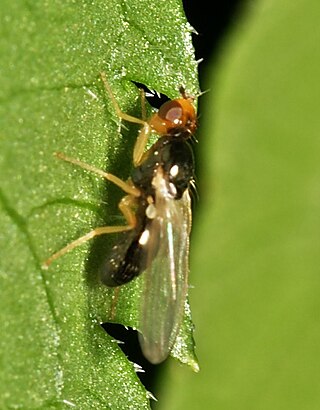
The Psilidae are family of flies. Commonly called the rust flies, at least 38 species are in four genera. The carrot fly is a member of this group. They are found mainly in the Holarctic.

The Agromyzidae are a family of flies, commonly referred to as the leaf-miner flies for the feeding habits of their larvae, most of which are leaf miners on various plants. It includes roughly 2,500 species, they are small, some with wing length of 1 mm. The maximum size is 6.5 mm. Most species are in the range of 2 to 3 mm.

The Lauxaniidae are a family of acalyptrate flies. They generally are small flies with large compound eyes that often are brightly coloured in life, sometimes with characteristic horizontal stripes, such as in Cestrotus species. Many species have variegated patterns on their wings, but in contrast they generally do not have variegated bodies, except for genera such as Cestrotus, whose camouflage mimics lichens or the texture of granitic rocks.

The Lonchaeidae are a family of acalyptrate flies commonly known as lance flies. 610 described species are placed into 10 genera. These are generally small but robustly built flies with blue-black or metallic bodies. They are found, most commonly in wooded areas, throughout the world with the exception of polar regions and New Zealand. Details of the distribution of genera and species by biogeographic realm are included in the World Catalogue of the family Lonchaeidae

Opomyzidae is a family of acalyptrate Diptera. They are generally small, slender, yellow, brown or black coloured flies. The larval food plants are grasses, including cereal crops, the adults are mainly found in open habitats. Some species being agricultural pests.
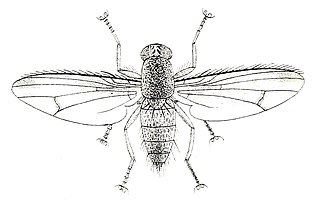
The Curtotonidae or quasimodo flies are a small family of small grey to dark brown humpbacked flies (Diptera) with a worldwide distribution, but with very few species in the Nearctic, Australasian/Oceanian, and Palaearctic regions. Most members of the family are found in tropical to subtropical latitudes in Africa and the Neotropics. Many remain undescribed in collections, since little work on the family has been done since the 1930s.
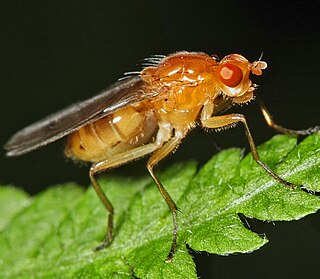
The Dryomyzidae are a small family of flies ranging from 4–18 mm long, with prominent bristles, and yellow to brown or rust-yellow coloring. The wings are very large. The subcosta is complete and well separated from vein 1. Larvae feed on decaying organic matter - carrion, dung, and fungi. The prelambrum protrudes from the oral cavity. Vibrissae are absent and the postvertical bristles are divergent.

Asteiidae is a small but widespread family of acalyptrate flies or Diptera. About 130 species in 10 genera have been described worldwide. They are rarely collected.
The Camillidae are a family of flies, or Diptera. The family has five genera.

Canacidae, incorrectly Canaceidae, or beach flies, surf or surge flies, is a family of Diptera. As of 2010, 307 species in 27 genera. The family now includes Tethininae as a subfamily.

The Coelopidae or kelp flies are a family of Acalyptratae flies, they are sometimes also called seaweed flies, although both terms are used for a number of seashore Diptera. Fewer than 40 species occur worldwide. The family is found in temperate areas, with species occurring in the southern Afrotropical, Holarctic, and Australasian regions.

Diastatidae are a family of flies in the order Diptera. They are encountered primarily in the Holarctic Region, but several species are found in the Oriental, Neotropical and Australasian regions. Members of the family number over 20 described species in three genera. There is an additional fossil genus.

Pallopteridae is a family of flies. The various species are collectively called flutter-wing flies, trembling-wing, or waving-wing flies, because of the striking vibration of the wings in many species. Over 70 species in about 15 genera are found in the temperate regions of the Northern and Southern Hemispheres.

Periscelididae is a family of flies.
